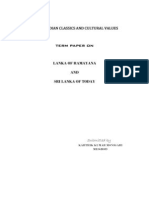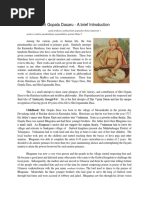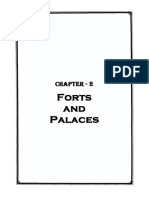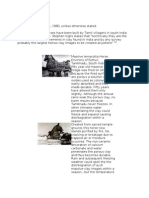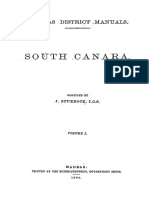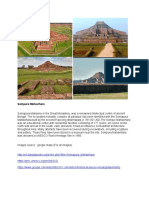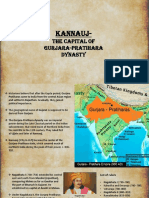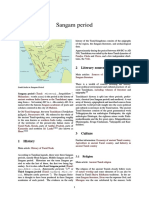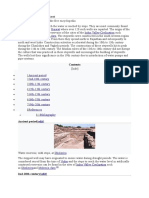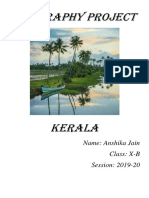Professional Documents
Culture Documents
Kerala Towards Modernity NOTES
Kerala Towards Modernity NOTES
Uploaded by
KitCopyright
Share this document
Did you find this document useful?
Is this content inappropriate?
Report this DocumentCopyright:
Kerala Towards Modernity NOTES
Kerala Towards Modernity NOTES
Uploaded by
KitCopyright:
Kerala towards Modernity
ARRIVAL OF EUROPEANS
OR
EUROPEANS FIGHT FOR TRADE MONOPOLY
● Europeans came by the end of the 15th century.
● The Chinese and Arab traders were followed by Portuguese, Dutch, French
and English traders.
● They fought over the monopoly of black pepper trade.
● They were all expelled, except for the British , from South India after the
Battle of Colachel.
ENGLISH EAST INDIA COMPANY IN KERALA
● Captain Keeling of the East India Company signed a trade agreement with
Zamorin of Kozhikode.
● They built a fort in Anchuthengu, which became an important military
centre of the British.
● The Attingal Revolt of 1721 was the first revolt in Kerala against the British.
● Malabar and later, Travancore came under British rule through the
Sreeranga Pattanam Treaty.
RESISTANCES AGAINST BRITISH
1. Pazhassi Revolt
● In Malabar, Pazhassi Raja of Kottayam led the resistance against the
British.
● He used guerilla warfare against them with the help of other leaders, like
the Wayanad Kurichias.
2. Veluthampi and Paliathachan reacted against British interference in
their internal affairs.
● They made an armed resistance at the British Resident Macaulay.
KERALA IN THE WORLD MARKET / WORLD TRADE
OR BRITISH TRADE CHANGES IN KERALA
● Britishers got access to Kerala’s goods at cheap prices which they sold in
the market at high rates
● They amended existing trade laws and introduced unified coinage systems.
● Transportation networks like roads and railways were improved for
movement of goods.
● Ports were built in Kochi, Kozhikode and Alapuzha.
PLANTATIONS AND TRADITIONAL INDUSTRIES
● British set up plantations of cash crops like tea, coffee and rubber in large
scales.
● Traditional industries of coconut, coir, handloom etc were developed too.
● Alappuzha became the hub of the coconut oil industry.
● Tile and Beedi factories were also set up.
RISE OF MODERN INDUSTRIES
● Modern industries were set up in the 20th century in Kochi and
Travancore.
● They received technical and financial support from the British.
● For example: Tata Oil Mills in Kochi.
● Nedungadi Bank was the first bank set up in Kerala.
BRITISH INFLUENCE IN CULTURE
● Printing arrived in Kerala with the Europeans.
● Jesuit Missionaries published grammar texts and dictionaries.
● Mr. Gundert published the first Malayalam newspapers called
“Rajyasamacharam” and “Pashchimodayam”.
● Educational programmes by missionaries brought education to everyone,
regardless of caste and religion.
● Land rulers helped in building schools and colleges and released “The
Proclamation of Free Primary Education”.
● The British also reformed law in Kerala.
● Modern medicine , like the smallpox vaccine was introduced.
● Patrilineal inheritance was made law.
SOCIAL REFORM MOVEMENTS IN KERALA
● THE CHANNAR WOMEN : They fought for right to cover their upper
body.
● UNDER SRI NARAYANA GURU, Lower caste people gained right to
perform poojas in temples.
● He also gave importance to education as the way to social change.
● THE VAIKOM SATYAGRAHA:
● They fought for the right to travel.
● The lower castes got permission to travel the roads around Vaikom temple.
● STRUGGLE FOR TEMPLE ENTRY FOR ALL CASTES:
● The Temple Entry Proclamation granted access for all castes to enter
temples.
NATIONAL MOVEMENT IN KERALA
MALABAR
● The Malabar Conference was the first step to discuss political issues.
● The Khilafat Movement led to fights with the British.
● During the Civil Disobedience Movement, people broke the law to make
salt and boycotted Kadhi.
● Peasant workers fought against the Janmi system and British imperialism.
TRAVANCORE
● The Malayali Memorial was submitted to seek equal representation in
government jobs.
● The Ezhava Memorial raised the problems faced by the Ezhava community.
● The Muslim and Ezhava communities fought for reservations in
government jobs.
● The Punnapra-Vayalar protest was led by the working class against
administrative reforms.
KOCHI
● The Electricity Agitation was the beginning of struggle for Responsible
Government.
● The formation of “Cochin Rajya Praja Mandalam” strengthened the
protests.
WOMEN IN THE MOVEMENT
● Women actively participated in protests and boycotts and raised their voice
against injustice.
● The first Women’s Conference was organised in 1931.
● Some prominent women leaders were: Kuttimalu Amma and Akkamma
Cherian.
THE FORMATION OF UNIFIED KERALA
● The common language was the unifying factor that brought the Malabar,
Kochi and Travancore together in the Kerala Congress Committee.
● The Unified Kerala Resolution was passed, and made Kerala a single,
united state.
● Kerala became a state on November 1, 1956 after the protest for states
based on common language.
You might also like
- Doctors Kerala 1 4070Document192 pagesDoctors Kerala 1 4070Sangeeth Saseendran50% (2)
- Case-Poabs GreenDocument9 pagesCase-Poabs GreenUnmesh RajguruNo ratings yet
- Tejpal TempleDocument20 pagesTejpal TempleAdi KaviwalaNo ratings yet
- Martand Sun Temple - Jammu and KashmirDocument2 pagesMartand Sun Temple - Jammu and Kashmirpradipkumarpatil0% (2)
- Lanka of Ramayana and Sri Lanka of Today-ModifiedDocument9 pagesLanka of Ramayana and Sri Lanka of Today-ModifiedanchimeriNo ratings yet
- MediAssist Kerala Hospital ListDocument5 pagesMediAssist Kerala Hospital Listtijuantony0% (3)
- HISTORY of Kalimpon Bhutan and Sikkim and DarjeelingDocument7 pagesHISTORY of Kalimpon Bhutan and Sikkim and DarjeelingGanesh PrasaiNo ratings yet
- Shri Gopala Dasaru - A Brief IntroductionDocument3 pagesShri Gopala Dasaru - A Brief IntroductionGopal GNo ratings yet
- Indus Valley Civilization From Takshila ClassesDocument12 pagesIndus Valley Civilization From Takshila ClassesSøûrâv Kümär RøyNo ratings yet
- Chola DynastyDocument21 pagesChola DynastyAnushka KhatriNo ratings yet
- Mughal ArchitectureDocument11 pagesMughal ArchitectureJatin TilwaniNo ratings yet
- Chola KingsDocument70 pagesChola Kingsict_labNo ratings yet
- My Early InfluencesDocument2 pagesMy Early InfluencesIruthaya SanthoseNo ratings yet
- KuvempuDocument2 pagesKuvempuvenkatesh vs100% (1)
- Kerala History - History of Kerala - Landmarks in Kerala History - Various Eras in Kerala HistoryDocument6 pagesKerala History - History of Kerala - Landmarks in Kerala History - Various Eras in Kerala HistoryHari650No ratings yet
- 07 Chapter 2Document40 pages07 Chapter 2Atul GargNo ratings yet
- Indus Valley CivilizationDocument29 pagesIndus Valley CivilizationKritika JuyalNo ratings yet
- Humayun's Tomb and Its Surroundings PDFDocument28 pagesHumayun's Tomb and Its Surroundings PDFKritika SimliNo ratings yet
- Aiyanar HorseDocument16 pagesAiyanar HorsenathanthephoenixNo ratings yet
- Maurya EmpireDocument63 pagesMaurya EmpireVishal MauryaNo ratings yet
- 15 Pallava ArchitectureDocument2 pages15 Pallava ArchitectureMadhu BabuNo ratings yet
- Famous Indian MonumentsDocument10 pagesFamous Indian MonumentsNidhi100% (1)
- The Beginning of South India History PDFDocument406 pagesThe Beginning of South India History PDFkrishna2205No ratings yet
- Kerala History 2Document35 pagesKerala History 2praveen nmNo ratings yet
- Ajanta II Phase CharacteristicsDocument46 pagesAjanta II Phase Characteristicsayeeta5099No ratings yet
- Udupi The City of Sri Krishna and MadhvacaryaDocument3 pagesUdupi The City of Sri Krishna and MadhvacaryaMayank DixitNo ratings yet
- Akbar Birbal and The Mughal SwagDocument14 pagesAkbar Birbal and The Mughal SwagaritrasixthsenseNo ratings yet
- Sivarajayogi Thycaud Ayya SwamikalDocument5 pagesSivarajayogi Thycaud Ayya SwamikalDr.KanamNo ratings yet
- Chola Empire History Study Material NotesDocument3 pagesChola Empire History Study Material NotesmonikasamhiNo ratings yet
- V R E T C: Edic Oots of Arly Amil UltureDocument16 pagesV R E T C: Edic Oots of Arly Amil UltureRebecca Tavares PuetterNo ratings yet
- South Canara 1Document12 pagesSouth Canara 1mallukallanNo ratings yet
- Ellora Caves: By-Hetvi A-006Document20 pagesEllora Caves: By-Hetvi A-006Hetvi Shah100% (1)
- 18Document25 pages18RAUSHAN KUMARNo ratings yet
- Gupta EmpireDocument27 pagesGupta Empirearchitectfemil6663100% (1)
- 7.1 Mughal EmpireDocument21 pages7.1 Mughal Empiregaurishagrawal1257_6No ratings yet
- Yadava Shilahara TemplesDocument17 pagesYadava Shilahara TemplesKrisha DesaiNo ratings yet
- The Mystery of Munroe Island by Victor GhosheDocument18 pagesThe Mystery of Munroe Island by Victor GhosheSujeeth Kamath0% (1)
- KeralaDocument17 pagesKeralachaudharyashu070No ratings yet
- Sompura MahaviharaDocument1 pageSompura Mahaviharadrax100% (1)
- Junagadh Rock Inscription of RudradamanDocument9 pagesJunagadh Rock Inscription of Rudradaman056Albin Joy 219No ratings yet
- The Gupta Period: By-Manish ShrivastavaDocument16 pagesThe Gupta Period: By-Manish ShrivastavaMayank DwivediNo ratings yet
- Pre MauryanDocument16 pagesPre MauryanChandan Kumar RoyNo ratings yet
- Acheivement of HarshavardhanaDocument3 pagesAcheivement of HarshavardhanaRabi kr. roy 80No ratings yet
- Archaeological and Literary SourcesDocument6 pagesArchaeological and Literary Sourcesmanishkarnani100% (1)
- 07 - Chapter 2 PDFDocument32 pages07 - Chapter 2 PDFVageesha100% (1)
- Jayakumari PH.D FinalDocument96 pagesJayakumari PH.D FinalKrishna McCallisterNo ratings yet
- Arakkal Kingdom: Arakkal Kingdom Was A Muslim Kingdom in Kannur Town inDocument7 pagesArakkal Kingdom: Arakkal Kingdom Was A Muslim Kingdom in Kannur Town inPGIndika100% (1)
- Makara in Indian SculptureDocument5 pagesMakara in Indian SculpturePrantik Gupta100% (1)
- Delhi Sultans and There ArchitectureDocument28 pagesDelhi Sultans and There ArchitectureShubham DuaNo ratings yet
- Ill An Go OeuvreDocument41 pagesIll An Go OeuvreRamanathan VekatNo ratings yet
- 3 Kannauj - Capital of Gurjara-Pratihara Dynasty PDFDocument8 pages3 Kannauj - Capital of Gurjara-Pratihara Dynasty PDFAshok BhargavaNo ratings yet
- 17 Indo-Islamic Architecture (Indian Culture Series - NCERT) PDFDocument7 pages17 Indo-Islamic Architecture (Indian Culture Series - NCERT) PDFsarawalem1No ratings yet
- ManipravalamDocument5 pagesManipravalamJithinrajNo ratings yet
- Sangam PeriodDocument5 pagesSangam Periodts pavanNo ratings yet
- Fatehpur SikriDocument33 pagesFatehpur SikriVaidehi EPNo ratings yet
- History of Stepwells in GujaratDocument9 pagesHistory of Stepwells in GujaratrameshnelaturiNo ratings yet
- KarnatakaDocument50 pagesKarnatakaBhaveesh SandeepNo ratings yet
- Clothing in Sangha PeriodDocument9 pagesClothing in Sangha PeriodPraveen KumarNo ratings yet
- Krishnaraja Wadiyar IIIDocument5 pagesKrishnaraja Wadiyar IIIvkumarab11No ratings yet
- Khilji DynastyDocument18 pagesKhilji DynastyDevyani TotlaNo ratings yet
- The Indian Emperor: "Boldness is a mask for fear, however great."From EverandThe Indian Emperor: "Boldness is a mask for fear, however great."No ratings yet
- Lessons for Mrs Hauksbee: Tales of Passion, Intrigue and ScandalFrom EverandLessons for Mrs Hauksbee: Tales of Passion, Intrigue and ScandalNo ratings yet
- A Study On Significance of Backwater Tourism and SDocument8 pagesA Study On Significance of Backwater Tourism and SElsa kNo ratings yet
- R Venkataraman Alwarkurichi Resume 2016Document27 pagesR Venkataraman Alwarkurichi Resume 2016Anonymous a1xCRVJNo ratings yet
- DIP - AlappuzhaDocument22 pagesDIP - AlappuzhaNizar AlifNo ratings yet
- SpicesDocument42 pagesSpicesDeepu LeelNo ratings yet
- Hotline To GodDocument3 pagesHotline To Godt_rajith1179No ratings yet
- University of Kerala: Reporting Time: 08.00 Am To 10.00 AmDocument4 pagesUniversity of Kerala: Reporting Time: 08.00 Am To 10.00 AmBalakrishnanNo ratings yet
- Kerala FestivalsDocument58 pagesKerala FestivalsNithin PradeepNo ratings yet
- Rastra DeepikaDocument85 pagesRastra DeepikazanNo ratings yet
- Huge Document PDFDocument4 pagesHuge Document PDFAnonymous czrvb3hNo ratings yet
- Kollam District - WikipediaDocument12 pagesKollam District - WikipediaAslam KtNo ratings yet
- Economic History of Kerala From 1800 To 1947 Ad: Part I: MalabarDocument68 pagesEconomic History of Kerala From 1800 To 1947 Ad: Part I: Malabarvishnu.hNo ratings yet
- It Is Specially So in Developing Countries Like India.: 1.1.2 The Role of Banks in Rural ReconstructionDocument26 pagesIt Is Specially So in Developing Countries Like India.: 1.1.2 The Role of Banks in Rural ReconstructionSANJU8795No ratings yet
- Geography ProjectDocument31 pagesGeography ProjectAnshika Jain100% (1)
- Paradise HolidaysDocument4 pagesParadise HolidaysPavan Kumar KondapalliNo ratings yet
- Kritis of Swati TirunalDocument181 pagesKritis of Swati TirunalUpadhyayula Surya Raghavender100% (1)
- Catlist MDocument106 pagesCatlist MAdon JosephNo ratings yet
- Marine Biodiversity of KeralaDocument4 pagesMarine Biodiversity of KeralaJalaja Thattan KandyNo ratings yet
- Mohammed Haris: ObjectiveDocument3 pagesMohammed Haris: ObjectiveAf ZalNo ratings yet
- India and Kerala Economy PDFDocument73 pagesIndia and Kerala Economy PDFSyamkumar UnnikrishnanNo ratings yet
- Lab HTMLDocument5 pagesLab HTMLSinan KNo ratings yet
- 09 Chapter2 PDFDocument33 pages09 Chapter2 PDFCheshta ChauhanNo ratings yet
- Kalyan StoresDocument5 pagesKalyan StoresChaudhary ShivNo ratings yet
- Keral - Final PlanDocument3 pagesKeral - Final PlanRohan GuptaNo ratings yet
- Exporter Contact Details 2019-2020Document62 pagesExporter Contact Details 2019-2020Naresh PhalswalNo ratings yet
- Statistical Report General Election, 1960 The Legislative Assembly KeralaDocument139 pagesStatistical Report General Election, 1960 The Legislative Assembly KeralaAKHIL H KRISHNANNo ratings yet
- E-catalogue-KeralaTourism - Part7.Document48 pagesE-catalogue-KeralaTourism - Part7.anishsrNo ratings yet
- Kottayam: Open Main MenuDocument6 pagesKottayam: Open Main MenuSkkaoNo ratings yet




